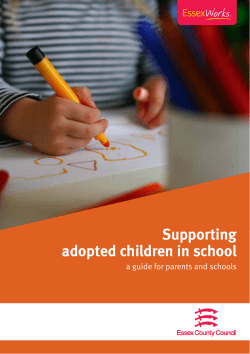
Creating a Family Crisis Management Plan (FCMP)
Creating a Family Crisis Management Plan (FCMP) 0 One of the most disruptive events that affects the family is when one member (often the child or family member with a disability) goes into crisis. Because the family functions as a unit, the crisis can quickly snowball into an incident where other members become engaged in the crisis, and one family member (often the child with the disability) is removed from the home – he or she goes to jail, the hospital or into out of home placement. Individual family members can become triggered, by either external (school, friends, outside stress) or internal (feelings of sadness, anxiety) factors. If mom, dad and the kids aren’t communicating, this has the potential to snowball throughout the family. If mom is overstressed from the care giving role, if Mary is being bullied at school, or if Dad and Mary are fighting about Mary’s grades, these can set the stage for a family crisis. Being aware of the things that trigger us and our children and other family members, identifying ways to deal with these triggers and making sure we have things in place in our family life to help us stay healthy on a day to day basis can help avoid, or at least lessen the effect of a family crisis. In the field of addiction relapse prevention, the pioneering work of Marlett and Gordon, Gorski and Daley discovered relapse prevention techniques that can help people in many areas of life other than addictions. They described the concepts of triggers, early warning signs, distraction and substitution as tools for relapse prevention. Since then, their work has found wide applications to various settings by both professionals and consumers in self help formats. For families, these ideas have been applied at several VO sites, for example Colorado and New Mexico. These concepts are used throughout the family crisis management plan. Components of the Family Crisis Management Plan The family crisis plan essentially has three components: Recognition, Prevention, and Intervention. The specific activities associated with these three components are: 1. Describe your own personal triggers, and things that trigger other family members. (Recognition) 2. Recognize early warning signs that signal when your family may be approaching a crisis (Recognition) 3. Identify appropriate wellness responses to possibly avert a crisis (Prevention). 4. Develop an action plan to deal with triggers before they happen. (Prevention) 5. Develop an action plan that will keep family members safe if a situation does escalate into a crisis. (Intervention) 6. Create a plan that lists actions you can take to keep your family well (Prevention). 1 Family Crisis Management Plan - Worksheet Family Wellness 1. What does my family look like when we are well (How do we act? How do we talk to each other? How do we feel)? 2. What are some of the things that help me and my family maintain a state of well being? 3. What does each family member look like when they are well? 4. What does each family member do to keep that state of well being? Plan for well being 1. The vision I have for my family is: 2. Make a list of things I and my family can do to move toward our vision. 2 Recognition of Triggers 1. Describe external triggers that can trigger me or my child to go into crisis. (For example, “When Mary has a bad day at school, she gets angry at her brother and me and starts yelling. I respond by getting angry and this can escalate into a crisis.”) What are some steps I can take to keep external triggers from escalating into a crisis? What are some steps my children can take to keep external triggers from escalating into a crisis? 2. Describe internal triggers (thoughts, feelings) that can cause me or my child to go into crisis. (For example, “Sometimes, Mary gets anxious and panicky for what seems like no reason at all. When she is like this, she gets out of control.”) What are some steps I can take to keep internal triggers from escalating into a crisis? What are some steps my children can take to keep internal triggers from escalating into a crisis? 3. Describe interpersonal triggers that may cause me or my family members to go into crisis (For example, “When Johnny refuses to do what I ask him, I get so mad because I think he is just being oppositional. I get mad, and he never does end up doing what I ask. It escalates into a fight.”) What are some steps I can take to keep interpersonal triggers from escalating into a crisis? What are some steps my children can take to keep interpersonal triggers from escalating into a crisis? 3 Recognition of Early Warning Signs 1. What actions are early warning signs that a situation may escalate into a crisis? 2. What feelings are early warning signs that a situation may escalate into a crisis? 3. What behaviors are early warning signs that a situation may escalate into a crisis? 4. What comments or statements are early warning signs that a situation may escalate into a crisis? What are the things I can do to help avoid a crisis? 4 Intervention If I know a crisis can’t be avoided, what are the first things I have to do to keep me and my family safe (including the child who is in crisis)? Instructions: Think through each step and list it in order of occurrence. For example: 1. What will I do with younger children? 2. Where will I go? 3. Who do I need to contact? (list phone numbers of important people in a crisis: ) 4. What information do I need to have close by? (For example: list of child’s medications, child’s doctor, allergies, prescriptions and dosages of medications, other health problems that professionals need to know about). 5. What has worked well in the past to soothe or calm my child? 6. What has NOT worked well in the past to calm my child? 7. What do I need to do to take care of myself after the crisis? a. Who to call b. Activities to do 5 Example Only Family Crisis Plan Family Member Task Phone Number Mom Call doctor 719-555-5555 Sister/Brother Take younger kids to neighbor 719-555-3333 Sister/Brother Call Dad 719-555-6666 Mom Handles child/youth in crisis Dad Mom Comes home from work and takes care of siblings (Example: takes them for ice cream) Calls Aunt Jenny after the crisis is over for support 719-555-8787 Using the above example as a guide, create your own Family Crisis Plan on the next page. 6 Family Crisis Plan Family Member Task 7 Phone Number Prevention List things I can do to keep my family well. List things I can do to keep my self well. Final Words If, despite your best efforts, the crisis explodes, be calm and act rationally. Try not to personalize the issue. Be aware of the following guidelines: • • • • Don’t threaten your child. This may cause him or her to become more excited or afraid. Don’t shout. Loud voices add to the sense of chaos. Continue speaking, but do so in a normal tone of voice. Don’t dare your child to act on what she is threatening to do. This will only engage her in a power struggle. Don’t block the doorway, but don’t let your child leave. Be prepared to call the authorities. A child who runs away from home puts him/herself in danger. A child who is threatening suicide or threatening to hurt someone else is also in danger. You want him/her safe, even if legal consequences result. 8
© Copyright 2025









